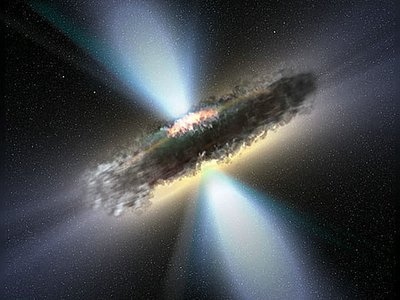Study finds two supermassive black holes spiraling toward collision
 A pair of supermassive black holes in the distant universe are intertwined and spiraling toward a merger that will create a single super-supermassive black hole capable of swallowing billions of stars, according to a new study by astronomers at the University of Virginia, Bonn University and the U.S. Naval Research Laboratory.
A pair of supermassive black holes in the distant universe are intertwined and spiraling toward a merger that will create a single super-supermassive black hole capable of swallowing billions of stars, according to a new study by astronomers at the University of Virginia, Bonn University and the U.S. Naval Research Laboratory.The study appears in the April 6, 2006 issue of the journal Astronomy & Astrophysics.
Black holes are among the oldest regions of the universe and hold clues to understanding the formation of the universe and its destiny. Though astronomers have theorized that coupled black holes exist, and that black holes sometimes merge and form supermassive black holes, the new study provides further evidence that this in fact occurs.
"The two key questions about supermassive black holes are: Where do they come from and how do they grow over time?" said Craig Sarazin, the W.H. Vanderbilt Professor of Astronomy at the University of Virginia and co-author of the study. "The birth, care and nurturing of supermassive black holes is a very active area of study in astronomy."
Supermassive black holes are areas in space that are so dense and massive they contain up to billions of stars and continually suck in more stars, further building their mass and gravitational pull. Even light cannot escape the pull of gravity in a black hole. The area appears as it is described: a black hole in space.
"Black holes are the ultimate garbage disposals," Sarazin said. "The material they swallow disappears without any trace, except for the gravity of the black hole."
Sarazin and his colleagues used NASA's Chandra X-ray Observatory to glean their results. Black holes are detectable because they produce large amounts of X-ray emission, similar to the radiation used for medical diagnosis. This high-energy radiation is invisible to our eyes, but can be seen with X-ray telescopes.
"There is no way to determine how a black hole was created or what kinds of things it has swallowed just by looking at the resulting black hole," Sarazin said. "You have to catch the black hole when it is sitting down to dinner or still eating." That, essentially, is what the Sarazin team has accomplished. They focused their observations on the center of a cluster of galaxies named Abell 400 where astronomers had previously suggested that a pair of supermassive black holes might be colliding. The two holes seemed to be relatively close together, but there was no proof that they were bound to one another or merging.
"The question was: Is this pair of supermassive black holes an old married couple, or just strangers passing in the night?" Sarazin said. "We now know that they are coupled, but more like the mating of black widow spiders. One of the black holes invariably will eat the other."
NASA is interested in helping astronomers better understand the formation of supermassive black holes and is currently planning to build an array of three space satellites called LISA (Laser Interferometry Space Antenna) to detect gravity waves from merging black holes.
"Obviously, astronomers would like to be certain that this process of supermassive black hole mergers really does occur, so that LISA will have something to detect," Sarazin said.
In recent years, astronomers have discovered that every large galaxy in the present day universe likely has a supermassive black hole. The Milky Way's own supermassive black hole has swallowed as much material as four million suns. The biggest galaxies contain black holes that have swallowed many billions of stars worth of material.
In some cases, two galaxies containing supermassive black holes collide and merge together, and eventually the two supermassive black holes fall into the center of the merged larger galaxy, and spiral together. Ultimately, they merge into one even larger hole. Sarazin's team found that the two merging supermassive black holes in Abell 400 appear to be swallowing gas from their host galaxy, and each is ejecting a pair of oppositely-directed jets of radio-emitting plasma. As the supermassive black holes fall through the gas in the cluster Abell 400, jets of radio-emitting plasma are swept back behind them.
"The jets are similar to the contrails produced by planes as they fly through the air on Earth," Sarazin said. "From the contrails, we can determine where the planes have been, and in which direction they are going. What we see is that the jets are bent together and intertwined, which indicates that the pair of supermassive black holes are bound and moving together."
By Craig Sarazin. Original Article here

0 Comments:
Post a Comment
Subscribe to Post Comments [Atom]
<< Home